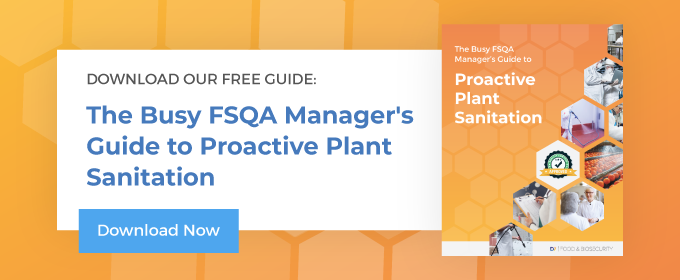
Bacteria and other pathogens are a constant challenge in many industries, especially food processing. Without treatment, these threats will continue to reproduce and can present health and safety risks to occupants and consumers, impact operational efficiency, and potentially damage the integrity of a brand.
However, when bacteria forms a biofilm, removal becomes even more difficult. The key is to prevent biofilms from forming in the first place, but when that doesn’t happen, it’s essential to be prepared with a plan for biofilm removal.
What Is Biofilm?
A biofilm is a collection of microorganisms that have formed a protective polymeric barrier, mostly made up of polysaccharides. Unlike free-floating bacteria that can be killed with chemical agents and gentle rinsing, the protective layer on biofilm often prevents treatments from penetrating, allowing the colony to continue growing. Biofilms attach to surfaces such as floors, ceilings, the insides of pipes, and on production equipment. When left untreated, biofilms will continue to grow, shedding bacteria into the surrounding environment and potentially contaminating work areas.
Industries Affected by Biofilm
Biofilms can be made up of a wide variety of microorganisms, such as bacteria and fungi. The noncellular components of the biofilm matrix can include materials such as clay, minerals, or corrosion particles. This means they can have an impact on a range of industries, including:
-
- Dairy
- Wine
- Marine
- Food processing
- Medical and personal care products
- And more
If biofilms are a potential risk in your industry, it’s essential to understand the importance of removing them and how to do so effectively.
6 Common Challenges with Biofilm Removal
Why is it so difficult to remove biofilm? There are several reasons:
1. Access
Biofilms often form in difficult to reach places that are missed by daily treatments. When these areas go untreated for too long, the risk of biofilm formation increases. These areas might include within refrigerated storage units, behind equipment, and inside drains. When possible, include these areas in daily cleaning protocols. If there are areas that cannot be accessed on a regular basis, be sure to include them in periodic deep cleans.
2. Mechanical Action
With many products, biofilm removal requires mechanical scrubbing because the strong extracellular matrix protects the bacteria within. If crews who use these products miss even a small area in their day-to-day cleaning, the biofilm will continue growing.
3. Treatment Visibility
With many products, it’s difficult to tell where treatment has been applied, especially if the application method is a liquid spray. Missed spots lead to biofilm formation, which if left untreated, could potentially have health consequences and also impact the integrity of your brand.
4. Bacterial Resistance
Many biofilms are resistant to common disinfectants—such as chlorine bleach—because of bacterial resistance. Consider using products that do not contribute to bacterial resistance, and rotate the types of disinfectants you use for daily cleaning and sanitation.
5. Human Behavior
Internal organizational culture must be focused on preventing biofilm formation. It can be challenging to get all employees on the same page, especially in larger organizations, but it is essential. In addition to training for biofilm prevention and treatment, include periodic refreshers to reinforce the importance of maintaining disinfection protocols and using proper application methods.
6. Insufficient Testing
Biofilms are invisible. If swabbing is always done in the same places, it can be easy to miss a hidden biofilm until it becomes a health hazard. Be proactive and look for biofilms in hidden areas when you do environmental testing.
Tackle Biofilms with Decon7 Products
Some of these challenges will always exist, but by incorporating Decon7 products into your daily disinfection and periodic deep cleans, you can remove existing biofilms and reduce the risk of biofilm formation. Products with D7 can penetrate biofilm walls* because of the detergent in the mixture. This means that no mechanical scrubbing is required, saving resources and minimizing production downtime.
The active agents in the solution do not just remove biofilms—they also kill the bacteria* inside at the DNA level. D7 is also effective with just one application, whereas most other products require three or more applications.
Additionally, the expanding foam clings to surfaces in areas that are difficult to reach, including drains, behind equipment, inside pipes, and so on. The foam also makes it clearly visible where the product has been applied, making it easier to ensure full coverage during application.
For more tips and best practices for avoiding biofilms in your food processing facility, read The Busy FSQA Manager’s Guide to Proactive Plant Sanitation.
*See label for specific use instructions

